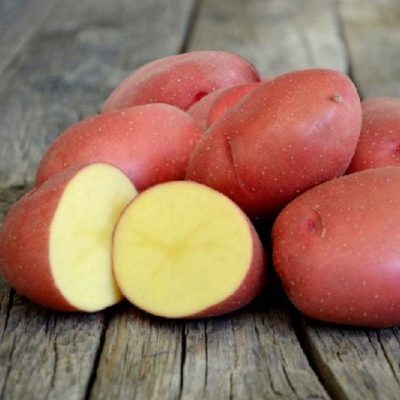
- Authors: Shanina Elena Petrovna, Dubinin Sergey Vladimirovich, Seregina Nadezhda Ivanovna
- Year of approval: 2017
- Appointment: dining room
- Tuber size: large
- Tuber weight, g: 95-140
- Peel color: red
- Color of the pulp: light yellow
- Starch content,%: 13,5-15,6%
- Tuber shape: elongated oval
- Peel structure: smooth
Krasa potatoes will delight you not only with high yield and unpretentiousness, but also with high marketability of root crops. This indicator is at around 79-99%.
Breeding history
The variety was decided to be allowed for use in 2007, so it is considered quite young. Several breeders were working on its breeding, which resulted in a good table potato with a lot of positive qualities.
Description of the variety
Krasa is valued today for the opportunity to grow bushes from seeds, which, in turn, are clean from fungal and other diseases that most often affect this vegetable. For many years, you can get a high-quality and, which is important, stable harvest.
Characteristics of the appearance of the bush and root crops
From the distinctive features of the plant, erect stems can be distinguished, which are usually tall or medium. The foliage of Krasa is dark green, rather large, however, like the resulting flowers, which are distinguished by a red-violet hue.
Tubers, with proper care and the required amount of dressing, grow large in Krasa, weighing 95-140 grams. They resemble an elongated oval in shape.
The peel is red, even, smooth, hiding light yellow flesh underneath. The eyes are shallow.
Root crops are perfectly stored for a long time in a cellar or in a warehouse with an optimal temperature of 2-4 degrees Celsius. Krasa's keeping quality is 94%.
Purpose and taste of tubers
Separately, it must be said about the taste of the Krasa variety. The potato belongs to culinary type B, excellent taste with a starch content of 13.5-15.6%.
One of the features of Krasa potatoes is ideal for first courses and mashed potatoes, as they boil well. At the same time, root crops retain their benefits. Krasa can also be used for baking in the oven or frying in a pan.
Maturation
Krasa potatoes are a mid-early variety, already 80-100 days after planting the tubers, you can get a good harvest.
Yield
This variety is in the high-yielding column. On average, this figure is at around 130-321 c / ha, but the maximum was recorded - 443 c / ha.
Each bush is capable of producing from 6 to 8 root crops, with proper watering and high-quality dressing.
Growing regions
Most often, the Kras variety can be found in the Central region of our country, but this does not mean that it is not planted in other regions.
Growing and care
It is possible to grow Kras potatoes not only with tubers, but also with seeds. In the latter case, the material must be pre-soaked in a humid environment. This is necessary because the germination rate of Krasa seeds is small. Next, the seed goes through a hardening procedure.
By the middle or end of March, Krasa can be planted in the ground. It is advisable to choose a sunny place, which must be treated with a fungicide before planting in order to reduce the likelihood of certain diseases.
The seed material of Krasa does not need to be deeply buried in the ground.You can speed up the germination process by covering the surface with a dark film. As a rule, after two weeks, you can see the first shoots, which you will definitely need to huddle.
Watering is carried out at least once every two weeks. Top dressing can be applied to the soil before planting. Urea is commonly used. Further, at the stage of maturation of Krasa tubers, universal complex fertilizers with a long-term effect have proven themselves well.

Planting potatoes is one of the main spring activities traditional for Russian gardeners. There are many ways to plant this vegetable, allowing you to get a good harvest in different conditions and climates. Before planting, you need to carefully prepare the planting material, correctly determine the timing, competently prepare the soil.


Soil requirements
For the Krasa variety, a neutral soil with a light structure and good air permeability is ideal.

Required climatic conditions
This variety copes well with drought, it is not afraid of mechanical damage. Its advantage is that it is able to acclimatize.
Disease and pest resistance
If we talk about the incidence of Kras potatoes, then it is resistant to fungal infections, but it is better to carry out preventive treatment with sulfur-based fungicides against viruses.
The leaves of this variety do not curl on the potato, it is not affected by cancer and golden nematode. And also, the gardener should not be afraid of wrinkled mosaics, but it is advisable to monitor the condition of the bushes in order to prevent late blight of tubers and leaves in time.

Potatoes are a popular vegetable crop that many gardeners planted on their site. But growing a bountiful harvest of tasty and large tubers is unlikely to succeed if the beds are not properly protected from the most common diseases and pests. Often, the development of diseases of various etiologies of potatoes goes unnoticed, so it is important to identify the problem in time and eliminate it.
















































































